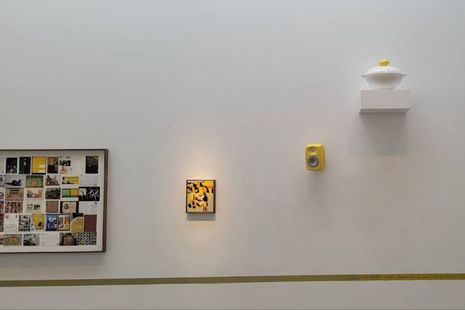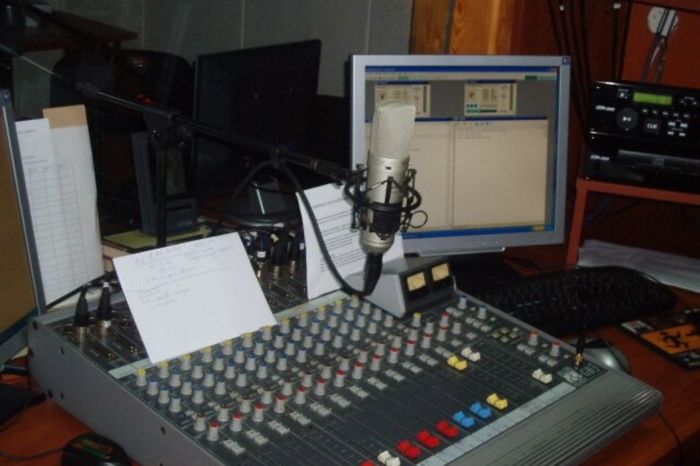Framing connection in ‘Another Chance Encounter’
Aaron Tan recalls his visit to a recent Kettle’s Yard exhibition, ‘Another Chance Encounter’

Lubaina Himid and Magda Stawarska have achieved something subtly exceptional in Kettle’s Yard’s latest show. In a manner quite novel and uncannily direct, they show how aesthetic experience might itself mediate individual and political levels of being.
The show radicalises the awkward encounter, making a strong case for its centrality to all acts of communication: between a couple, between a French artist’s ex-lovers, between artist and viewer. An artwork’s vitality, after all, lies in its inexhaustibility of meaning, the feeling you get of being spoken to while knowing that you will never quite perfectly understand it. I certainly got this feeling standing within the rich, dense, and puzzling spaces Himid and Stawarska have created. Analogously, the awkward gap at the heart of conversation, the miscommunication that precisely is communication, also opens up a productive – and often political – space of change.
The first gallery’s display, entitled ‘How May I Help You? ’, is of a series of paintings by Himid, commissioned for this exhibition. Each painting features a pair of men engaged in a conversation, poised uneasily between financial transaction and intimate confession. The canvases marry bright palettes and bold forms with enigmatic compositions and ambiguous emotional registers. Unconventionally, their labels dramatise them, staging their imaginary conversations.
“The awkward gap at the heart of conversation, the miscommunication that precisely is communication, also opens up a productive – and often political – space of change”
In a filmed interview (viewable in the study space upstairs), Himid tells us that these paintings are concerned with moments that are “incredibly important for what’s being said, as opposed to what’s being thought while that thing is being said.” Indeed, what emerges from these imaginary conversations, emerges not from any psychological depth that the canvas’s painted subjectivities might possess, but the awkward social dynamics typified on its surface. One character thinks at another, as a label tells us: “I don’t need persuading in this way, I would buy even more goods than I do from you already but sometimes you talk too much […] Please calm down and let me stay a while with you, in silence, simply looking and feeling the quality of the weave.”
A slippery blend of the erotic and mercenary renders even this interior utterance of desire inscrutable; a missed connection results from the distorting effect of pervasive commercial relations. In the same interview, Stawarska reflects, “really, the whole exhibition is about exchange.” Certainly, a semantic gap is opened up in the word ‘exchange’ itself, encapsulating the awkward mark of imperfection embedded in the act of communication. This gap between commercial and emotional exchange not only describes the awkward encounters Himid depicts, but diagnoses them.
Himid’s paintings invite viewers into a shifting, disorienting social space, a concept which the second gallery’s multimedia installation, ‘Slightly Bitter’, makes literal. Letters and postcards uncovered in the Kettle’s Yard archive, exchanged between Polish writer Sophie Gaudier-Brzeska and Welsh artist Nina Hamnet, serve as Himid and Stawarska’s material. Both Gaudier-Brzeska and Hamnet were former lovers of the French artist Henri Gaudier-Brzeska, whose work formed a sizeable part of the original Kettle’s Yard collection. Both were working together to secure Henri’s artistic legacy after his death in World War I. The tone of their exchange – “sharp and edgy and also sort of unsatisfactory somehow”, as Himid puts it – informs the unruly assemblage of materials arranged across the gallery’s four walls.
“The contingency of these connections, always imperfect in their inability to represent the web’s totality, compresses the challenging impulse to connect”
Among video screens featuring rotating lemons, a door, and words exchanged in their own personal lives, Himid and Stawarska have also attempted to re-create lost (or imagined) paintings from Gaudier-Brzeska and Hamnet’s descriptions. Pervading the space between them is a trilingual soundscape in English, French, and Polish, instantly immersing visitors in the experience of imperfect communication. One recurrent motif here is the postcard. A large pinboard of them, evoking a fragile web of shared and exchanged memories, invites viewers to draw connections within. The contingency of these connections, always imperfect in their inability to represent the web’s totality, compresses the challenging impulse to connect.
This impulse is formally and emotionally felt throughout the entire installation, analogising how every precious chance encounter is marked by its inverse: the missed one. The awkwardness of conversation – small misunderstandings, the delay of a postcard’s arrival, simmering mutual jealousy – are precisely, the installation palpably evokes, the complexities upon which relationships are built. Elsewhere, Himid and Stawarska have also playfully placed small, easy-to-miss artistic interventions in the Kettle’s Yard House, and unexpected encounters with them while exploring the House exemplify the surprise of aesthetic experience.
Finally, in the learning space upstairs, this social resonance of aesthetic form in the main galleries is given specific political meaning, set against Lubaina Himid’s early artistic practice. A pioneering member of the Black Arts movement of the 1980s, Himid was one of the first British artists to explicitly confront the institutional racism of the art world in the UK.
The room is filled with the awkward, difficult conversations that these early efforts entailed – including a failed application for a residency at Kettle’s Yard itself. Awkward conversations, as these materials testify, are the very stuff of change, slightly bitter but necessary. As Himid and Stawarska’s show makes enigmatically felt, awkwardness can be a call for attention – not to surrender to misunderstanding, but to heed what the misunderstanding itself reveals.
 News / Caius mourns its tree-mendous loss23 December 2025
News / Caius mourns its tree-mendous loss23 December 2025 News / Clare Hall spent over £500k opposing busway 24 December 2025
News / Clare Hall spent over £500k opposing busway 24 December 2025 Comment / Yes, I’m brown – but I have more important things to say22 December 2025
Comment / Yes, I’m brown – but I have more important things to say22 December 2025 Comment / The ‘class’ of Cambridge24 December 2025
Comment / The ‘class’ of Cambridge24 December 2025 Interviews / Politics, your own way: Tilly Middlehurst on speaking out21 December 2025
Interviews / Politics, your own way: Tilly Middlehurst on speaking out21 December 2025








